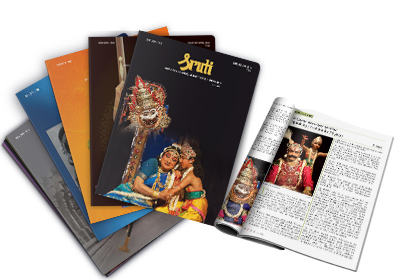
The tricky triplets
It is not unusual in Indian classical music for the same swara material to yield a multiplicity of ragas, with none of the siblings obviously derived from any of the others. An interesting example of such ragas is of the triplets – Marwa, Pooriya and Sohini in Hindustani music. The three ragas have identical swara material: Sa-re-Ga-Ma-Dha-Ni. They are distinguished from one another by the distinctive sequencing of swaras or phraesology, and by a variety of subtler prescriptions which are not commonly understood, or documented.
By definition, all ragas are performed to base-Sa, at the pitch the musician fixes it. In addition to base-Sa, these three ragas, because of their different centres of gravity, have different notional scale-bases, consistent with their primary melodic territory.
The contemporary Marwa has a notional scale-base at the lower octave Dha swara, thus making Dha-Ni-re-Ga-Ma-Dha its notional scale. Pooriya’s notional scale-base is the same as the actual scale-base at base-Sa. Some might argue, probably with some validity, that Pooriya’s notional scale-base is at the lower octave Ni. If we accept this argument, the notional scale of Pooriya would be Ni-re-Ga-Ma-Dha-Ni. Sohini, a resident of the higher frequencies, has its notional scale-base at the middle octave Ga. Thus, the notional scale of Sohini is: Ga-Ma-Dha-Ni-re-Ga.
Speaking of their respective identities, Vilayat Khan said that if you walked into an auditorium ten minutes after Marwa had been performed well, the walls would still be resounding with the phrase Ni-Dha-Dha in the lower octave. Similarly, the lasting aural image of a well-delivered Pooriya would be the phrase Ma-Ma-Ga in the middle octave. And, finally, the dominant residual impression of Sohini should be Dha-Ni-Sa-re-Sa on the border between the middle and higher octaves.
Broadly, Marwa emphasises the robust treatment of the swara material, with a generous dose of geometric/ symmetric improvisation. The Pooriya treatment is subtle, profound, and largely melodic. Sohini’s character, is lyrical, playful, and replete with ornamentation and frills.
By the time-theory governing music performance, all three ragas belong to the sandhi-prakash or twilight zone. Marwa and Pooriya are prescribed for performance around sunset, while Sohini is considered appropriate around sunrise. (Bhatkhande Sangeet Paddhati, 1944)
Marwa
The contemporary Marwa differs substantially from its documentation in the 1940s. Bhatkhande describes Marwa as having its centre of gravity in the re-Ga-Ma-Dha region of the middle octave. He also states that Marwa is not as sombre as Pooriya but, instead, has a strident, aggressive demeanour. Since then, thanks to Ustad Amir Khan’s epic interpretation of the raga (EMI/HMV: STC:048:7327), its melodic focus has moved downwards into the region between the lower octave Dha and middle octave Re. Marwa has now acquired pathos, and lost some of its stridency. The contemporary Marwa retains the (komal) Re and Dha as its dominant swaras, as traditionally accepted; but the middle octave Dha has been replaced by the lower octave Dha.
Marwa risks confusion with Pooriya in the poorvanga, and Sohini in the uttaranga. The Marwa ascent towards the upper Sa is encouraged to omit the Ni swara (Ga-Ma-Dha-Sa), thus permitting a suggestion of raga Hindol.
One of the ways in which Marwa evades the shadow of Pooriya and Sohini is by discouraging the excessive use of base-Sa in its phraesology, and prescribing it for use only as an isolated swara. This feature imparts to it a predominantly pentatonic character. In addition, the resultant scale (Dha-Ni-re-Ga-Ma-Dha) creates an interesting tonal geometry, making the raga amenable to geometric/ symmetric, as well as kaleidoscopic types of improvisation.
If we break down the notional raga scale into three pairs of contiguous swara-s (Dha-Ni/ re-Ga/ Ma-Dha), the lowest pair (Dha-Ni) stands out as a virtually isolated pair, with a pitch frequency ratio of 1:1.125. The other two pairs (re-Ga/ Ma-Dha) have higher, and identical proportions (1:1.185), and thus constitute similar pairs.
This may explain the special status, and attraction, of the Ni-Dha pair as the melodic signature of the raga. It leaps out from the fabric of the music, because it is acoustically different, and has a wedge-like sharpness that the other two pairs do not. This wedge becomes poignant when rendered in the lower octave (the contemporary Marwa), and severe one octave higher (the traditional Marwa).
Skeletal phraesology or chalan:
S/ N. r N. D. D./ N. D. r/ G r/ M G r/ r G M D/ D M D/M N D/ D M D S/ N D r/ N r N D/
D M G r/ G r/ N. D. r/ S
Pooriya
The dominant swaras in Pooriya are Ga and Ni (Marwa has re-Dha). According to some authorities, the (komal) re to be used in Pooriya is a suppressed micro-swara of the standard komal Re swara. Vilayat Khan utilises this suppressed micro-swara frequently by pulling the string from base-Sa.
Pooriya makes a normal use of base-Sa (Marwa discourages, Sohini virtually ignores). In the ascent towards the upper-Sa, the raga encourages omission of Dha and Ni swaras, so that the Sohini illusion is avoided. In the descent, Dha and Ga are recommended for subliminal treatment, so that the Marwa shadow does not fall on Pooriya.
Despite the lower tetrachord (middle octave) centre of gravity, Bhatkhande considers it permissible for Pooriya to descend deep into the lower octave down to Ga. Amir Khan, whose Pooriya (Navras: NRCC: 0092) too is some kind of landmark, uses this feature generously. Vilayat Khan does not do so, and retains a strong middle octave focus.
Skeletal phraesology:
G N. r S/ N. D. N./ N. r G r G/ M M G/ G M D
G M G or M N G M G/ G M D M S/ N r N M M G/
M r G/ N. r S
Sohini
Sohini attempts to utilise whatever remains of the melodic potential of this swara material, after Pooriya and Marwa have exploited it. In reality, what remains is very little. The skeletal phraesology of the raga is also virtually its exhaustive melodic potential. Sohini is, thus, not very much more than a song.
The melodic span of the raga is also limited to its notional scale. Its presentation is discouraged from going either below the middle octave Ga, or above the higher octave Ga.
This is why Sohini is performed most commonly in the semi-classical or light genres of vocal music, whose aesthetics are governed by the varied and subtle ornamentation of each poetic idea enshrined in a melodic phrase. This is also the reason why classical performers either present this raga with dazzling artistry, or feel encouraged to take liberties with its melodic frame, though never with its swara material.
The dominant swaras in Sohini are the higher octave Sa and the middle octave Ga. In the ascent, the (komal) re swara is generally omitted, and in the descent, it is treated subliminally. Unless deftly handled, the descent into the lower tetrachord can, therefore, provide a fleeting glimpse of Pooriya.
Skeletal phraesology:
G M D G M G/ r S/ N. S G/ M D N S r S/ S r N S D N/ N D G/ M G r S
The skeletal phraesologies of the three ragas do, as they indeed must, have some common or tangential phrases. This is the heart of the issue. These ragas are differentiated more in the sculpting of their residual aural images than in what can be laid down as their grammar.
Theory in performance
It is not easy to find recordings of the three ragas, performed one after the other, and distinguished from each other as precisely as their theoretical constructs would demand. I had the opportunity of studying one such recording of Vilayat Khan, made by India Archive Music, New York. He reportedly recorded them in a single session. The only other case of this kind has been Bade Gulam Ali Khan’s reported rendition of these ragas in succession at a concert in the 1940s.
In the Vilayat Khan recording, Marwa is presented as an alap, Pooriya as a slow tempo composition, and Sohini in a fast tempo composition, with a jhala appended to it.
Although the ragas share the same swara material, each of them has its distinctive skeletal phraesology incorporating the essential grammar. However, in the improvisational process, grammar alone cannot help a musician avoid the risk of blurred aural images. To counteract this risk, these ragas have evolved identities shaped by practices which belong to the region of prescriptive rather than mandatory grammar. These prescriptions pertain to the relative importance of specific regions of the melodic space, and of specified directions for the melodic thrust.
This facet of raga identity rests on the hypothesis that the emotional communication of the lower tonal frequencies is qualitatively different from that of the higher frequencies. As a corollary, the aesthetics of descending melodic movements are presumed to be different from those of ascending movements.
The contemporary Marwa becomes accessible in the poorvanga of the middle octave, and the lower octave, and through descending movements. Relative to Marwa, Pooriya shifts upwards a little, with a concentration in the poorvanga of the middle octave, but still relying on descending melodic thrusts. Sohini moves into forward gear with a powerful upward thrust, targeting the uttaranga of the middle octave, and higher octave. See the melodic plot of the three renditions. The plotting of the graph utilises the exponential scale of pitch frequencies. The three octaves will therefore not look equal (see below). The lower octave scale-base is calibrated at 1. The middle octave Sa is calibrated at 2, the higher octave Sa is calibrated at 4.
This same recording was also analysed on the ratio of descending to ascending melodic thrusts in each of the ragas. It was found that ascending thrusts dominated Marwa, descending thrusts were predominant in Pooriya, and ascending thrusts were predominant in Sohini. This pattern, of course, also reflects the fact that the three ragas are presented through different movements. But, in their totality, the pattern supports the principle of raga differentiation beyond simplistic notions of grammar.
In these patterns, Vilayat Khan’s Marwa appears to correspond to its orthodox (pre-Amir Khan) stridency. The Pooriya pattern confirms the profound poorvanga biased personality of the raga. And, Sohini is transparent as a lively and frolicsome raga of the uttaranga region. Greater precision in measuring such patterns is now possible using digital melodic analysis software. The manual methods used here are, however, sufficient for interpreting the aesthetic intent. They deliver adequate evidence to establish purposive artistic behaviour and to rule out pure chance.
Most musicians achieve, or perhaps only approximate, such patterns intuitively. They just ‘know’ it when “it sounds right”. And, this is why Marwa, Pooriya and Sohini are popular ragas with which a vast majority of musicians and their audiences are very comfortable. But, when great musical minds commit themselves to such artistic challenges as performing the tricky triplets in succession, the subtlest nuances of ‘raga tatva’ become quantifiable, and the raga becomes a transparent instrument of psychoacoustic engineering.
(The ragas Sohini and Pooriya are also often spelt as Sohni and Puriya/ Pooria).
Deepak S. Raja © India Archive Music Ltd., New York
(The author is an accomplished sitarist, musicologist, music critic and author. He blogs at swaratala.blogspot.com and has edited and written books on Hindustni music)


